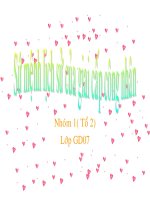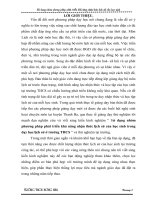COCO CHANEL HISTORY LỊCH sử của NHÃN HIỆU COCO CHANEL
Bạn đang xem bản rút gọn của tài liệu. Xem và tải ngay bản đầy đủ của tài liệu tại đây (6.18 MB, 44 trang )
COCO CHANEL
(19 August 1883 – 10 January 1971)
BAHA
AR
ZAMI
NDAR
SEM - III
Introduction
• Gabrielle "Coco" Bonheur Chanel (19 August 1883 – 10 January 1971) was a French
fashion designer and founder of the Chanel brand.
• She was the only fashion designer to appear on Time magazine's
list of the 100 most influential people of the 20th century.
• Along with Paul Poiret, Chanel was credited with liberating women from the
constraints of the "corseted silhouette" and popularizing the acceptance of a sportive,
casual chic as the feminine standard in the post-World War I era.
• A prolific fashion creator, Chanel's influence extended beyond couture clothing. Her
design aesthetic was realized in jewelry, handbags, and fragrance. Her signature scent,
Chanel No. 5, has become an iconic product.
Early life
• The Chanel family did not have money.
• No one knew how to spell Chanel so the mayor
improvised and recorded it with an "s,"
making it Chasnel.
• When Gabrielle was twelve, her mother died of
tuberculosis, and her father disappeared.
• School vacations were spent with relatives .
Female relatives taught Coco to sew with more flourish than the nuns at the monastery were able to
demonstrate.
• When Coco turned eighteen, she left the orphanage.
• She found a job as a shopkeeper specializing in the lines and wares.
Later she became a singer and dancer in a music hall, where she got
the name Coco.
Career/Life Path
• Gabrielle adopted the name “Coco” during a brief
stint as a singer in cafes and concert halls
• While working at a tailoring shop she met and
soon began an affair with Etienne Balsan
• Coco left Etienne and took over his apartment
in Paris.
• In 1908 she began selling hats from the basement
shop in Etienne’s apartment.
• She was forced to close her shop.
• In 1909 Chanel met up with an estranged and former best friend of Etienne Balsan, Arthur "Boy" Capel.
• 1910 she opened second shop funded by boy Capel in Cambon, Paris.
• 1913 she opened a clothing shop in Deauville , France funded by Capel .
• 1915 Her reputation was firmly established, Chanel opens her first Couture House in Biarritz, France.
• In 1916 Coco Chanel became the first designer to create loose women’s clothing using jersey.
• In 1919 Chanel relocated one of her shops to 31 rue Cambon in Paris.
• Coco also lost her true love, Arthur “Boy” Capel in a tragic car accident.
• In 1922, she launched the iconic fragrance Chanel No. 5.
• In 1925 Chanel launched her signature cardigan jacket.
• In 1924 CHANEL presents the first makeup collection, featuring lip colours and
face powders.
• In 1926 she created the “little black dress”.
• In 1931 at the personal request of Samuel Goldwyn, Gabrielle Chanel goes to
Hollywood to create outfits for the leading stars of the silver screen.
• In 1939 Chanel closed all her shops except the one on Rue Cambon No. 31.
• In 1954 she returned to the fashion world after spending 15 years in Switzerland.
• In 1955 Chanel launches the iconic 2.55 quilted handbag.
•
Death
• Coco Chanel died of a heart attack in her private suite at the Hotel
Ritz Paris on 10 January 1971, at the age of 87. She was buried in
Switzerland and her tombstone is carved with lion heads
representing her birth sign, Leo.
Chanel Logo
• The Chanel logo, designed by Coco Chanel herself in 1925, consists
of two interlocked and opposing letters “C” for her name, “Coco
Chanel”.
•
It remains unchanged since and at the same time, one of the most
iconic logos in fashion industry.
• A popular story suggests that it was inspired by the original Château
de Cremat logo; a pair of intertwined Cs. The Chanel logo was
notregistered as a trademark until the first Chanel shops were built.
Chanel Stores
Fashions that Chanel Introduced to the
world
- LITTLE BLACK DRESS
• All the famous innovations in fashion and design cannot outshine the fame of the single
Chanel Little Black Dress. Coco Chanel introduced it in a time between the wars, when the
bright colors, prints and heavy embroideries dominated the fashion.
The long-sleeved black dress, which was initially made for day in wool, and for evening in
crepe, satin or velvet, shook up the world of fashion. Later appeared the other variations of
a little black dress: short, sleeveless, in a pleated black chiffon, in black lace…
In 1926 American Vogue named Coco Chanel black dress "a Ford", meaning it’s simplicity
and it’s potential for an enormous and long-lasting success. It was the little black dress of
Chanel, that inspired the famous remark of her competitor Paul Poiret: "What has Chanel
invented? De luxe poverty."
The Chanel little black dress became a symbol of chic and sophisticated simplicity.
- CHANEL N.5
• It was in 1921, that Coco Chanel had created the
single most famous perfume in history, Chanel No.5.
• Chanel N.5 is the first designer perfume.
- COSTUME JEWELRY
• Over the past years, we've seen a serious resurgence of cheap and chic megajewels, from larger-than-life earrings to serious statement necklaces.
• But the pioneer of all of that faux bling is, without a doubt, Coco Chanel. The
designer, who was rarely seen without a heaping pile of pearls around her
neck, designed costume jewelry made from chains, beads, and glass that was
meant to be worn with her casual daytime sportswear as early as the 1930s.
•
Her reasoning was that if women could buy jewelry that was more affordable
than real gemstones, they could properly accessorize every outfit they had,
rather than sticking with a few simple pieces.
- TROUSERS
• It seems so simple now, doesn't it? You get up, you take a shower,
you "put on your pants one leg at a time, just like everybody else..."
but 80 years ago, that was a concept reserved strictly for bearers of
XY chromosomes.
•
Then along came Chanel, who decided that women should enjoy the
same freedoms as men, and that binding corsets and skirts were
physically holding them back. "I gave women a sense of freedom,"
she once said. "I gave them back their bodies: bodies that were
drenched in sweat, due to fashion's finery, lace, corsets,
underclothes, padding.“
•
When she decided there was no comfortable way to ride a horse
while wearing a long skirt, she literally took the pants off a male
rider and made them her own.
- CHANEL’S SIGNATURE CARDIGAN JACKET
In 1925, Chanel launched her signature
cardigan jacket.
- SAILOR TOPS
Nautical-inspired clothing is a classic look that began
with Chanel's sailor tops. The navy blue and white
stripes worn by French fishermen were the inspiration
behind her design.
- MADE JERSEY FABRIC FASHIONABLE
Coco Chanel outraged the fashion industry in 1917
by snubbing uncomfortable chiffon and
taffeta fabrics and turning to jersey knit,
which was deemed “cheap” and only used for
undergarments at the time. She newfound mobility
paved the way for women to enter the world of sports.
- POPULARIZED SUITES FOR WOMEN AND TURTLENECKLINES
- THE BOBBED HAIRSTYLE
- QUILTED BAG
1955, Gabrielle Chanel launches the iconic 2.55 quilted handbag,
naming the style after the date of its creation. Combining leather and
gold chain, she invents a supple new style of shoulder strap that is
uniquely strong and light, and that allows a woman’s hands to remain
free.









